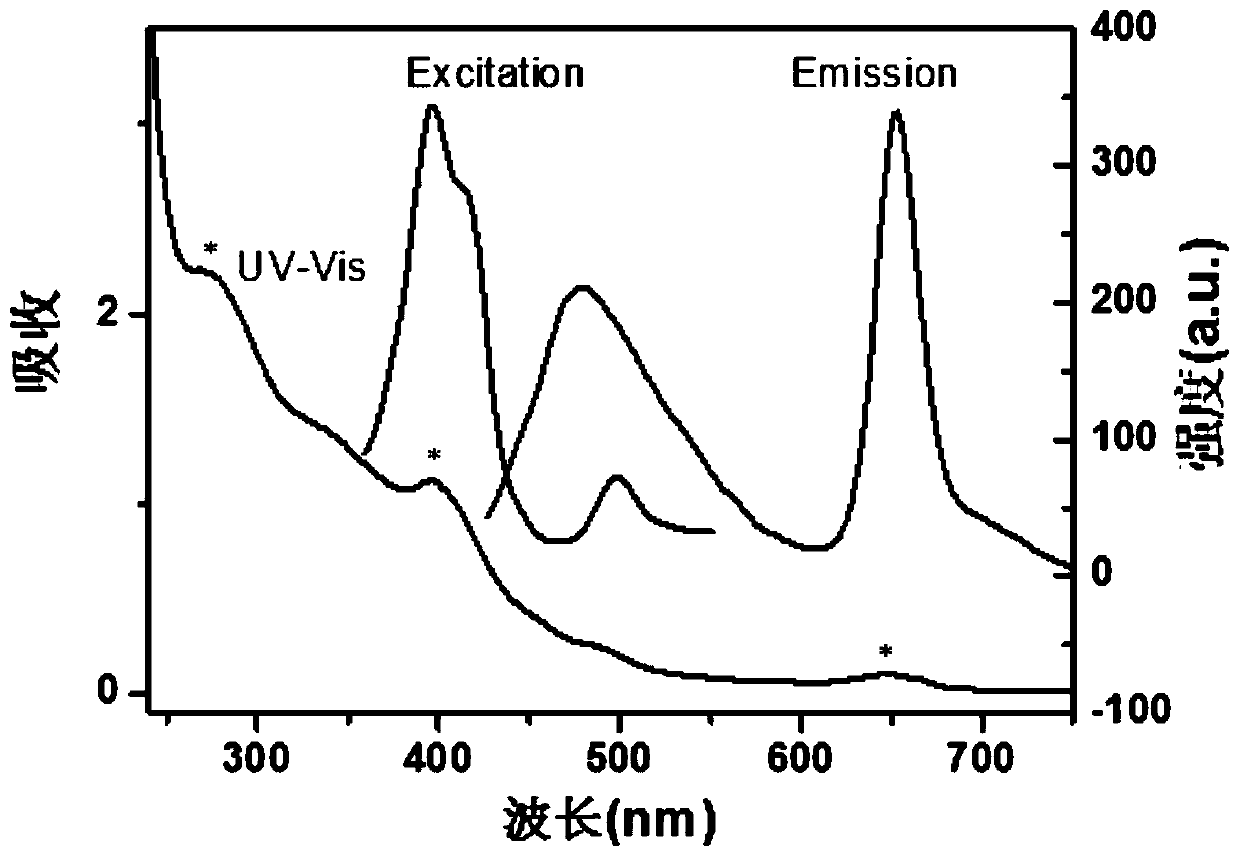Dual-emission fluorescent carbon dot and preparing method and application thereof
A dual-emission fluorescence, carbon dot technology, applied in luminescent materials, fluorescence/phosphorescence, chemical instruments and methods, etc., can solve the problems of expensive and complicated equipment, complicated operation, etc., and achieve low price, stable optical properties, and synthetic steps. simple effect
- Summary
- Abstract
- Description
- Claims
- Application Information
AI Technical Summary
Problems solved by technology
Method used
Image
Examples
Embodiment 1
[0028] Step 1, weigh 0.2g of spinach juice solid powder and 2mL of ethylenediamine respectively and place them in the reaction kettle, then add 20mL of secondary water, stir well, and ultrasonically obtain a clear solution;
[0029] Step 2, place the reaction kettle with the clear solution in an oven, heat at 120°C for 12 hours to obtain a brown solution;
[0030] Step 3: Take out the reaction kettle, cool it down naturally, filter to remove insoluble matter to obtain a clear solution, pass through a 500-1000Da dialysis bag, dialyze in a glass container for 1 day, and change the water every 4 hours to obtain pure carbon dots aqueous solution;
[0031] Step 4, freeze-drying the carbon dot aqueous solution to obtain a carbon dot solid, and its relative quantum yield (based on quinine sulfate) is 22.16%.
Embodiment 2
[0033] Fluorescent carbon dots prepared in Example 1 were characterized by fluorescence excitation emission and ultraviolet absorption spectrum (see figure 1 ), for TEM, IR and XPS characterization (see Figure 2-4 ), the particle diameters of the fluorescent carbon dots prepared by the present invention are all less than 10nm, and the surface contains groups such as carboxyl, hydroxyl, amino groups.
Embodiment 3
[0035] Get the fluorescent carbon dot aqueous solution (50 μ g / mL) 1.8mL that embodiment 1 prepares and place in the fluorescence cuvette, add 18 kinds of common metal ion solutions (10mmol / L) of 0.2mL respectively, mix homogeneously, in the fluorescence photometer Scan the emission spectrum (λex=391nm), and record the fluorescence intensity, such as Figure 5 As shown, carbon quantum dots on Pb 2+ Has good ion selectivity, Pb 2+ The fluorescence at 651nm of the carbon quantum dots can be quenched, and the fluorescence recovers after adding PPi. In order to calculate the carbon dots vs. Pb 2+ and the fluorescence detection range of PPi, get the fluorescent carbon dot aqueous solution (50 μ g / mL) 1.8mL that embodiment 1 prepares and place in the fluorescence cuvette, add the Pb of 0.2mL different concentrations (from low to high) respectively 2+ and PPi solution, mix uniformly, scan the emission spectrum (λex=391nm) in the fluorescence photometer, when Pb 2+ In the presence...
PUM
| Property | Measurement | Unit |
|---|---|---|
| particle diameter | aaaaa | aaaaa |
Abstract
Description
Claims
Application Information
 Login to View More
Login to View More - R&D
- Intellectual Property
- Life Sciences
- Materials
- Tech Scout
- Unparalleled Data Quality
- Higher Quality Content
- 60% Fewer Hallucinations
Browse by: Latest US Patents, China's latest patents, Technical Efficacy Thesaurus, Application Domain, Technology Topic, Popular Technical Reports.
© 2025 PatSnap. All rights reserved.Legal|Privacy policy|Modern Slavery Act Transparency Statement|Sitemap|About US| Contact US: help@patsnap.com



